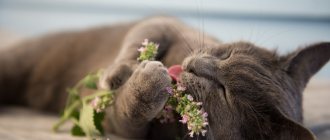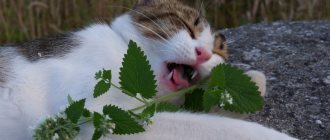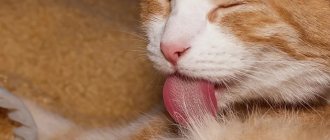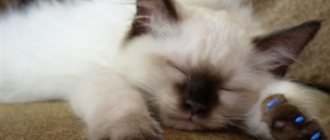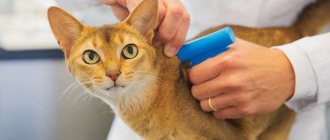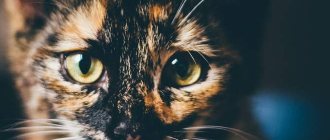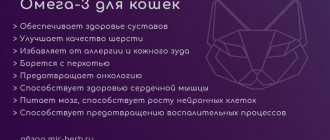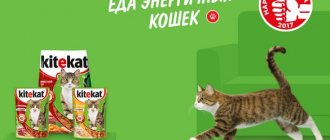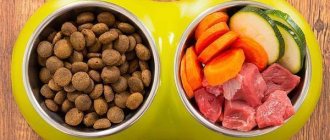Caring for a pet requires patience and responsibility. The most important point in this matter is a balanced diet, as a result of which the cat should receive all the necessary minerals, vitamins, trace elements and amino acids.
In this article we will tell you what taurine is, what its benefits are for the cat’s body, and why it is always included in modern foods and treats.
What is taurine and why does a cat need it?
Taurine is an amino acid. The mammalian body produces it itself. It turns out that pets are always lacking it. Cats that hunt and eat rodents naturally supplement their taurine deficiency. Pets need to add this element to their food.
They first heard about it when German scientists obtained it from ox bile. Taurine is created on the basis of cysteine, which forms tissues and other substances necessary for the body, and neutralizes toxins.
Why is taurine so necessary for cats? There are a few of the most basic reasons to be convinced of the importance of taurine:
- It strengthens the body's defenses . Those cats that do not have enough amino acids get colds more often and stay sick longer.
- The functioning of the liver and kidneys improves . Fats in the body are digested with the help of bile, in the formation of which taurine takes part.
- Sugar is normalized . Diabetes mellitus is very scary for cats, its treatment is quite difficult and expensive. On top of that, complications are possible.
- The digestive organs work better . No bloating, good digestion and absorption of nutrients, monotonous stools.
- Improving wool quality . It becomes shiny, smooth, does not climb, and takes on a healthy appearance. The animal looks well-groomed and beautiful.
- The cardiovascular system, brain and nervous system work harmoniously.
- The birth of healthy kittens . This amino acid is important in the development of the fetus and during the cat’s pregnancy.
Reference! Considering all of the above, it should be noted that this substance is vital. It is involved in many body processes.
Niacin ¶
The niacin requirement of many animal species can be met by synthesizing it from tryptophan. The potential vulnerability of felines due to niacin deficiency results from their inability to synthesize this vitamin from tryptophan. Naturally, deficiency of this vitamin is not usually observed, but cats are nevertheless dependent on a dietary source of niacin and it is necessary to ensure that it meets their needs.
Cats' requirements for nutrients such as calcium and phosphorus are similar to those of other mammals.
What happens to a cat’s body with taurine deficiency?
Taurine deficiency is not immediately noticeable. If the animal is healthy and has a strong body, then the lack of amino acids does not appear at all at first. If the following symptoms begin to be observed, then it is imperative to take measures:
- First, vision decreases . Observing your pet, you can notice that he began to bump into various objects, seemingly for no reason. The cat needs urgent treatment, as there is a risk of complete or partial blindness.
- Dilated cardiomyopathy develops . The first step to heart failure. Oxygen starvation and uneven heart rhythm appear. The animal begins to eat and move less, and its body temperature becomes lower. If noticed in time, the condition can be quickly cured.
- Dental problems. They break down and fall out.
- Frequent respiratory diseases . A persistent cough and cold in the respiratory tract should alert the owner.
- Blood clotting is impaired.
- Animal growth is impaired.
- Increased nervousness and fearfulness of the cat.
- Complications during pregnancy and childbirth . Kittens may be born with birth defects or premature.
Even if there is not enough taurine in small quantities, the animal becomes lethargic, inactive, and eats poorly. Some advanced diseases may no longer be curable. Therefore, you need to provide your pet with adequate nutrition and care.
Attention! Breeders must monitor the taurine content in the diet of their pets to ensure healthy offspring.
Atherosclerosis
There are several possible mechanisms for reducing atherogenesis with taurine supplementation.
First, in many studies in animals with atherosclerosis, the use of taurine reduced serum cholesterol levels. During the decline in serum cholesterol levels, hepatic cholesterol levels decreased more rapidly, mainly due to an increase in 7α-hydroxylase activity, which accelerates cholesterol degradation. Since there was a correlation between lower serum cholesterol levels and the treatment dose of taurine, it was assumed that increased expression of the CYP7A1 gene in the liver played a role in regulating serum cholesterol levels. Also, treatment with taurine is associated with a decrease in the activity of 3-hydroxy-3-methylglutaryl-CoA reductase [24].
Secondly, it was shown that contact of liver cells within 24 hours with a medium containing taurine leads to a decrease in the biosynthesis of cholesterol esters and triglycerides. Since the content of triglycerides and cholesteryl esters in the liver determines the assembly of lipoproteins in the endoplasmic reticulum of the liver, taurine specifically inhibits the assembly and secretion of lipoproteins containing the structural protein apolipoprotein B100 (apoB100) [24, 25]. ApoB100 is the primary structural protein of both low-density lipoproteins (LDL) and their precursors, very low-density lipoproteins.
Thirdly, taurine protects endothelial cells of vascular tissue from glucose- and oxidized LDL-induced toxicity, which is an early stage in the development of atherosclerosis [26]. It is possible that taurine also protects endothelial cells from homocysteine-induced endoplasmic reticulum stress and apoptosis by reducing hyperhomocysteinemia [27].
Fourth, taurine suppresses the proliferation of vascular smooth muscle cells caused by platelet-derived growth factor-BB (PDGF-BB), which plays an important role in the development of atherosclerosis [28]. Taurine modifies the activity of phosphatase, which dephosphorylates the PDGF-β receptor (a strong chemoattractant and proliferative factor for vascular smooth muscle cells).
Fifth, taurine reduces the expression of oxidized low-density lipoprotein receptors (which mediates the uptake of oxidized LDL into endothelial cells) and reduces the incidence of stenosis in rabbits with oxidative stress from iliac artery balloon injury [29].
Finally, sixthly, inhibition of atherosclerosis may occur due to the anti-inflammatory effect of taurine. The WHO-CARDIAC epidemiological study showed that the inclusion of taurine in the diet correlates with a decrease in mortality in patients with coronary heart disease [30]. Elvevoll et al. (2008) [31] found that taurine enhances the effectiveness of omega-3 fatty acids in reducing total cholesterol, LDL and triglycerides.
What foods contain taurine?
In the wild, cats obtain this essential element by catching rats, mice and other rodents. Their meat contains the most essential microelements and taurine for the body.
Advice! Each cat should receive an average of 1000 mg of amino acid per kilogram of dry food and 2000 mg of wet food per day.
Taurine has been added to cat food since the 70s. Currently, all dry and wet foods contain taurine. It must be said that in cheap economy class food the taurine content does not meet the daily requirement, so it is better to switch to other food or buy vitamins.
For dogs, this element is not added, because the dog’s body produces it on its own. Therefore, you cannot use dog food for cats!
Important! Boiled meat has a lower taurine content than raw meat. Owners who feed boiled food to their pets should be aware that it does not contain enough substances necessary for the cat. Additional additives must be used.
Consider natural products for cats containing taurine:
| The product's name | Taurine content (mg / 100g) |
| Dark meat turkey (thigh) | 360 |
| Raw tuna | 284 |
| Dark meat chicken | 170 |
| Raw red fish | 130 |
| Chicken by-products | 117 |
| Beef heart | 65 |
| Necks and backs of chickens | 58 |
| Raw beef | 43 |
| Boiled beef meat | 38 |
| Rabbit meat | 37 |
| Cod raw | 31 |
| Light turkey meat (breast fillet) | 30 |
| Raw chicken fillet | 18 |
| Carp | 9 |
In general, the leaders in taurine content are seafood and fish: shrimp, mussels, tuna, oysters. But these expensive products are unlikely to be the basis of nutrition for domestic cats. Therefore, the main sources of amino acids on natural feeding will be: dark meat of turkey, chicken, chicken and beef offal.
Introduction
Taurine is a β-amino acid found in very high concentrations in most cells of the body, especially in excitable tissues. Although taurine has many functions in mammals, its cytoprotective properties have attracted particular attention from researchers because they significantly alter the health and nutritional status of a subject. The ability of taurine to regulate fundamental processes occurring in the cell, changing the balance of life and death in it, has aroused interest in the study of its physiological functions. The results of these scientific works have stimulated research into the therapeutic effects of taurine and its nutritional value, from which encouraging conclusions have been drawn [1, 2]. Of particular note is a World Health Association study involving 50 populations in 25 countries, which found that increased taurine intake was associated with a reduced risk of hypertension and hypercholesterolemia [3, 4]. Taurine supplementation also leads to a decrease in body mass index and levels of inflammatory markers in obese women [5]. Thus, the cytoprotective effect of taurine improves human health.
Amino acid in industrial feeds
We reviewed several popular brands of dry cat food. The dosage of taurine may vary from batch to batch, so the data presented in the table is an average.
| Name of food | Taurine content mg/kg |
| Brit Care Sterilized | 2300 |
| 1st Choice | 2100 |
| Royal Canin | 1700 |
| Pro Plan | 1500 |
| Grandorf | 1500 |
How to preserve sulfonic acid when preparing natural cat food?
This amino acid is found in maximum concentration in raw foods, but meat and fish cannot always be given to a cat in an unprocessed form. We are talking mainly about river fish, which can be infected with helminths. In this case, you need to steam or bake it. When cooked, taurine is “washed out,” so when using this type of treatment, you should give your pet broth as well. Fried foods a priori should not be given to animals, as this negatively affects their health.
A lot of taurine is lost when food is defrosted, so it is worth buying chilled meat and live fish. When the fillet is severely chopped and placed under pressure, the concentration of sulfonic acid also decreases.
Harm of taurine
After numerous studies, it was found that taurine does not harm the cat's body. Excess taurine that is not absorbed by the body is excreted in the urine. The main harm of the amino acid lies in the cat’s individual intolerance to taurine. But this is quite a rare occurrence.
Symptoms of too much taurine include food allergies, gastrointestinal upset, and muscle weakness. Only a veterinarian can determine the final diagnosis and treatment.
Overdose symptoms
Since the cat’s body cannot produce taurine on its own, the owner is obliged to ensure that the pet meets this need. It is very rare, but quite possible, for cat owners to overdo it.
An overdose can be considered if the following symptoms are present:
- the appearance of itchy rashes on the skin of the pussy;
- persistent vomiting and diarrhea.
As a rule, excess taurine in food is eliminated without problems by the body of a kitten and an adult kitty. Therefore, cats that have an individual intolerance to this sulfur-containing acid more often suffer from the listed adverse reactions.
Prevention
Seafood, raw meat, especially heart or brain are rich in taurine. It is better to give meat to the animal, having previously chopped it into medium pieces, since finely chopped and beaten meat contains less taurine.
To prevent diseases during natural or economical feeding, it is best to use nutritional supplements. Their use protects the cat’s retina from atrophy and helps the animal feel healthy.
Diagnostics
The diagnosis of taurine deficiency can be made by a veterinarian after a physical examination of the cat. Diagnostics may include the following research methods:
- general blood analysis;
- general urine analysis;
- biochemical blood test;
- electroretinogram - examination of the retina of the eye;
- ECG.
If taurine deficiency is suspected, your cat may have an electrocardiogram.
Vitamins with taurine
The range of vitamins is quite diverse, so this issue does not cause difficulties. You need to be prepared that the price will not be small. Before buying them, it is better to first consult a doctor to know for sure that these vitamins will not harm your cat:
- Beaphar Kittys Taurine + Biotin . Shape: hearts. Flavor: cheese. There are 180 pieces in a package.
- Omega Neo . Contains squid liver. You can take 3-6 tablets, which contain essential amino acids, for a whole year.
- Gimpet . Shape: hearts or mice. For small pets 3-4 tablets, for adult cats - up to 6 tablets per day.
- Doctor ZOO for cats Biotin + Taurine. There are 90 tablets in a package. When taken, metabolism improves.
- Petvital Vitamin-Gel . Vitamin gel. Prevents the development of urolithiasis.
Ischemia-reperfusion injury
The effects of taurine, such as antioxidant effect, modulation of Ca2+ ions, osmoregulation, regulation of protein phosphorylation and high-energy phosphate, influence the outcome of ischemia-reperfusion injury (IRI). To date, the use of taurine is limited to heart transplantation and coronary artery bypass grafting (CABG). Several studies have shown the benefits of using taurine as a component of cardioplegic solutions or saturating hearts with taurine before using them as donors. In addition to oxidative stress and edema, decreased taurine levels in IRI result in decreased Na+ levels, which reduce osmotic stress and Ca2+ overload [16, 32]. In addition, rapid intravenous infusion of taurine before CABG prevents oxidative stress and cell necrosis [33].
Signs of food allergies
How can you tell if an animal has a food allergy? To do this, you need to know the symptoms of a cat's food allergy. The most striking signs of the disease are:
- Severe itching of the body (the cat itches literally incessantly, unable to fully relax even during sleep);
- The appearance of hairless areas on the body as a result of constant scratching (initially on the face, ears, stomach, limbs, and if left untreated, bald patches form in other areas);
- Ulcers and purulent blisters on the skin due to dental trauma;
- Redness and darkening of the skin;
- Mucus discharge from the eyes, nose and ears;
- Heavy breathing, shortness of breath even with minimal exertion;
- Cough;
- Frequent sneezing due to itching in the nose;
- Swelling of the extremities;
- Sometimes vomiting and diarrhea;
- Sometimes a slight increase in temperature;
- Nervousness, anxiety (the cat is almost constantly in a bad mood);
- Loss of appetite.
Advantages
First, let's talk about the advantages of using dry pet food.
Owners of domestic cats note convenience as the first advantage. It is very easy to store food this way. You can use any convenient container for storage. You can also leave the product in its original packaging.
Plastic containers, which are found in every home, will work great. Separately, it is worth noting the long shelf life of the products and convenient use. To feed your furry pet, just open the package and pour the required amount of food into a bowl.
Manufacturers offering products of the highest quality produce food with a balanced composition. First of all, a premium product has this quality. Properly selected components and substances are necessary for the excellent health and well-being of your pet.
Without the use of ready-made food, cat owners have to create their own menu, taking into account the characteristics of a particular breed and the beneficial qualities of each individual product. Trading companies offer food for various age groups, taking into account the developmental characteristics of cats at each stage.
If you are the owner of a purebred cat, you will definitely be interested in breed-specific food. It is very difficult to independently select and calculate a menu for a specific type. Manufacturers have already done this for you and have taken into account the characteristics of each breed. When preparing food, the pet’s predisposition to disease, taste preferences, need for certain substances, and much more are taken into account.
It is especially worth noting medicinal food, which helps animals recover after surgery or illness. They contain special components aimed at improving the condition of the body. You will also find formulations for pregnant and lactating cats on sale.
The next advantage is the abrasive properties of solid food granules. This food helps cleanse teeth from plaque. However, even with regular use of dry food, it is necessary to brush your pet's teeth. Unfortunately, some owners neglect this responsibility.
The product contains taurine. This is a special component that is essential for the health of the animal. This element is required for:
- maintaining excellent vision of the animal;
- prevention of heart disease;
- participation in digestive processes (the substance helps digest and absorb fat in the small intestine);
- stabilization of the nervous system.
Taurine is found in fish, beef and seafood. If such food is rarely or completely absent from the cat’s diet, dry food will help cope with the problem of taurine deficiency. READ Antigadin for cats
Important Tips
Taurine is of particular importance for cats, since this substance cannot be synthesized on its own. It is worth paying attention to several rules for its introduction into the diet:
- This medication is sold in pharmacies without a prescription. This does not mean at all that you can buy it and give it to an animal for absolutely any ailment. The supplement can be given only as prescribed by a specialist, after a comprehensive diagnostic study.
- It is strongly not recommended to skip taking the vitamin, as the effectiveness of treatment will noticeably decrease. If this cannot be avoided, then in no case should the animal be given a double dosage of medication at the same time to fill this gap.
- You should closely monitor your pet for several days after taking the supplement. If frequent diarrhea occurs, you should stop taking it. You should contact a specialist to adjust your treatment.
Cats are the most common pets. They are always affectionate, sweet and kind. Is it possible to allow this lovely creature to suffer from taurine deficiency in the body?!
>Taurine for cats
Features of digestion
The domestic cat very rarely gets its own food, and, nevertheless, by nature it remains a predator. This is evidenced not only by the habits of the hunter, but also by the structural features of the teeth, designed for capturing and tearing raw meat. Cats lack the molar chewing teeth that omnivores have.
Cats eat calmly and measuredly, carefully sorting and chewing their food. Even in almost homogeneous food, they will definitely find something they don’t like. These features have given the animals a reputation as capricious and picky eaters. Therefore, cat food, both at home and in industry, is made from higher quality ingredients than, say, for dogs. In addition, cats prefer warm food. This is due to their carnivorous nature. In nature, these predators eat only fresh meat. Smell and taste are of great importance to cats.
Conservative in food and habits, they are reluctant to try new foods
And to attract the attention of gourmets, the industry adds special flavoring components. Cats are indifferent to sweets because they simply cannot distinguish the taste
A very important point in the attractiveness of cat food is its moisture content, consistency, hardness and size of the ingredients.
Farmina (hypoallergenic)
The cat food has earned decent reviews. The manufacturer produces samples that significantly reduce the occurrence of allergic reactions in animals. This is possible due to the absence of popular allergens such as corn and wheat.
However, it must be remembered that the basis of the Farmina diet is high-quality meat. Lamb is mainly used, but chicken is also present. Therefore, this food is not suitable for cats with difficulties digesting meat.
Hypoallergenic foods are free from grains that contain gluten. This is the strength of the brand. Spelled and oats are added instead. They do not cause allergies, promote excellent digestion and control metabolism.


